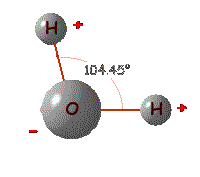Water is found almost everywhere on the planet earth as well as many other bodies in the solar system and is required by all known life.
Although salty sea-water covers seven tenths of the earth's surface, only 2.5 per cent of the planet's water is fresh. Of this, two thirds is locked in glaciers or snow as ice or unavailable because it is in deep aquifers.

| WATER DISTRIBUTION ON EARTH |
| Total Volume | 1,360,000,000 km� | 316,900,000 mile� | |
| Oceans | 1,320,000,000 km� | 326,000,000 mile� | 97.2% |
| Glaciers & Icecaps | 25,000,000 km� | 6,000,000 mile� | 1.8% |
| Groundwater | 13,000,000 km� | 3,000,000 mile� | 0.9% |
Fresh Water
rivers, lakes, inland seas | 250,000 km� | 60,000 mile� | 0.02% |
| Atmospheric Water Vapour | 13,000 km� | 3,100 mile� | 0.001% |
Water is a remarkeable chemical compound composed of two hydrogen atoms attached to an oxygen atom, its chemical formula being H2O. The two strongly electropositive hydrogen atoms are attached to the strongly electronegative oxygen atom at and angle of 107.47° making the light molecule very polar and causing a strong attraction between adjacent molecules which results in water being a liquid and not a gas at the temperatures which are encountered on most of the earth's surface.

|
This phenomemon is caused by the small size of the highly electropositive hydrogen atom and is known as "hydrogen bonding" and is commonly encountered, particular in the chemicals associated with life - it is hydrogen bonding, for example, which holds many proteins in their usual shape.
|
| name | chemical
formula | molecular
weight | melting
point
(°C) | boiling
point
(°C) |
| Hydrogen | H2 | 2.02 | -259.12 | -252.88 |
| Methane | CH4 | 16.04 | -182.5 | -162 |
| Water | H2O | 18.02 | 0 | 100 |
| Oxygen | O2 | 32 | -222.8 | -182.97 |
| Ethanol ("alcohol") | C2H5OH | 46.07 | -114.3 | 78.4 |
| Pentane | C5H12 | 72.2 | -129.75 | 36.05 |
Water is a very good solvent, largely due to its electrical polarity. All of the many biochemical reactions which are part of the life process take place in aqueous solutions and water is the medium used to transport molecules within living things.
|
Seawater is salty because of the minerals which are washed into the oceans from the land and, because this is a continuous process, the world's oceans steadily increase in salinity with time. The salinity of living cells is considerably lower than that of the present oceans and it has been suggested that living cells have preserved the level of salinity of sea-water in which they developed.
|
Substances are generally classified as being either "soluble" (e.g.: sugar or common salt) or "insoluble" (e.g.: glass or lead). This is not strictly true as most "insoluble" substances such as glass do dissolve in water to some extent but the propertion is so small that, to most practical intents and purposes, such substances can be considered as being insoluble.
|
When scientists attempt to prepare water which is very pure, the solubility of glass becomes a problem and they use expensive platinum vessels because the solubility of platinum in water is so much less.
Pure or near-pure water is, quite literally, "tasteless", which is a quite unusual sensation. The "taste" of water as it is commonly encountered is due to presence in greater or lesser quantities of various impurities.
|
When a polar or ionic substance enters water, water molecules which are relatively small in size surround it and many water molecules typically surround a single molecule of the solute with the partially positive dipoles of the water attracting negatively charged compnents of the solute and vice versa. Thus, in general, ionic and polar substances such as acids, alcohols, and salts are readily dissolved in water while nonpolar substances such as fats and oils are not.
|
Nonpolar molecules tend to stay clumped together in water because it is more efficient energetically for the water molecules to maintain their hydrogen bonds to each other than to engage in van der Waals interactions with the molecules of a nonpolar solute.
|
Sodium chloride, common salt, is an example of an ionic solute which is very soluble in water. The sodium cloride consists of sodium cations (Na+) and chlorine anions (Cl-) which are readily surrounded by the small water molecules and easily transported away from their crystalline lattice into the solution.
Sucrose, common table sugar, is an example of a nonionic solute - the dipoles of the water molecules hydrogen bond to the dipolar regions of the sugar molecules, allowing them to be carried away into solution.
Soaps and detergents work by having a strongly ionic group attached to the long chain of a fatty acid. This long chain dissolves readily in other fats while the water molecules surround the ionic portions and carrying the fat into solution.
Because of the financial structure imposed on the British water supply industry when it was privatised, water supply companies can offset capital expenditure such as the cost of building new reservoirs against price increases, something they are not allowed to do with the costs of repairing leaks in the water supply mains. This tends to cause the British water supply companies to invest in capital projects rather than repair the considerable leakge which occurs from the distribution mains.
Consumer choice can also play a large part in water usage. A glass of fresh orange juice with breakfast is an innocuous enough item but it requires two hundred and twenty litres of irrigation water to produce the glass of juice and this in areas which are arid and where water is a precious commodity.
see also: Saving Water in the Home
|
| | | Links to Other Pages on This Site
|
| |
| | |
|
| | | Links to Other Sites
|
| |
| | |
Hits on this page since December 6th| Jan | | | | | Feb | | | | | Mar | | | | | Apr | | | | | May | | | | | Jun | | | | | Jul | | | | | Aug | | |  | | Sep | | |  | | Oct | | |  | | Nov | | | | | Dec | | |  |
current year:  | | previous year:  |
No messages posted on this page Only Members of the Site can post messages in this section. Signing in is easy from our Home Page. DISCLAIMER: Whilst we endeavour to ensure the content of this site is correct, we cannot undertake that information you find here, is, or will remain accurate and complete. We do not warrant that any information contained on this site is fit for any purpose. If you wish to place reliance on any such information you must check its accuracy by some other means before doing so. MEMBERS get aditional features on our pages and will soon be able to interact with the site and add their views and informastion. Sign up, from the Home-Page, is simple and involves typing in your email address and a password of your choice. If you are in any way connected with any location or interested in the subject mentioned on this page and have an hour or two a month to spare, we would welcome you as a local moderator - please email the webmaster by CLICKING HERE. Privacy Policy
|
|








